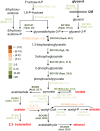Genome-Wide Investigation of Biofilm Formation in Bacillus cereus
- PMID: 28432092
- PMCID: PMC5478996
- DOI: 10.1128/AEM.00561-17
Genome-Wide Investigation of Biofilm Formation in Bacillus cereus
Abstract
Bacillus cereus is a soil-dwelling Gram-positive bacterium capable of forming structured multicellular communities, or biofilms. However, the regulatory pathways controlling biofilm formation are less well understood in B. cereus In this work, we developed a method to study B. cereus biofilms formed at the air-liquid interface. We applied two genome-wide approaches, random transposon insertion mutagenesis to identify genes that are potentially important for biofilm formation, and transcriptome analyses by RNA sequencing (RNA-seq) to characterize genes that are differentially expressed in B. cereus when cells were grown in a biofilm-inducing medium. For the first approach, we identified 23 genes whose disruption by transposon insertion led to altered biofilm phenotypes. Based on the predicted function, they included genes involved in processes such as nucleotide biosynthesis, iron salvage, and antibiotic production, as well as genes encoding an ATP-dependent protease and transcription regulators. Transcriptome analyses identified about 500 genes that were differentially expressed in cells grown under biofilm-inducing conditions. One particular set of those genes may contribute to major metabolic shifts, leading to elevated production of small volatile molecules. Selected volatile molecules were shown to stimulate robust biofilm formation in B. cereus Our studies represent a genome-wide investigation of B. cereus biofilm formation.IMPORTANCE In this work, we established a robust method for B. cereus biofilm studies and applied two genome-wide approaches, transposon insertion mutagenesis and transcriptome analyses by RNA-seq, to identify genes and pathways that are potentially important for biofilm formation in B. cereus We discovered dozens of genes and two major metabolic shifts that seem to be important for biofilm formation in B. cereus Our study represents a genome-wide investigation on B. cereus biofilm formation.
Keywords: Bacillus cereus; biofilm formation; transcriptome; transposon mutagenesis.
Copyright © 2017 American Society for Microbiology.
Figures






Similar articles
-
The spo0A-sinI-sinR Regulatory Circuit Plays an Essential Role in Biofilm Formation, Nematicidal Activities, and Plant Protection in Bacillus cereus AR156.Mol Plant Microbe Interact. 2017 Aug;30(8):603-619. doi: 10.1094/MPMI-02-17-0042-R. Epub 2017 Jun 19. Mol Plant Microbe Interact. 2017. PMID: 28430084
-
Characterization of the codY gene and its influence on biofilm formation in Bacillus cereus.Arch Microbiol. 2008 Jun;189(6):557-68. doi: 10.1007/s00203-008-0348-8. Epub 2008 Jan 24. Arch Microbiol. 2008. PMID: 18214442
-
Alternative modes of biofilm formation by plant-associated Bacillus cereus.Microbiologyopen. 2015 Jun;4(3):452-64. doi: 10.1002/mbo3.251. Epub 2015 Mar 31. Microbiologyopen. 2015. PMID: 25828975 Free PMC article.
-
Bacillus cereus spores and toxins - The potential role of biofilms.Food Microbiol. 2020 Sep;90:103493. doi: 10.1016/j.fm.2020.103493. Epub 2020 Mar 26. Food Microbiol. 2020. PMID: 32336372 Review.
-
Bacillus cereus Biofilms-Same, Only Different.Front Microbiol. 2016 Jul 7;7:1054. doi: 10.3389/fmicb.2016.01054. eCollection 2016. Front Microbiol. 2016. PMID: 27458448 Free PMC article. Review.
Cited by
-
Infections in patients with adverse reactions to the use of unknown modeling substances for soft tissue enhancement in Cali, Colombia.PLoS One. 2023 Feb 9;18(2):e0277958. doi: 10.1371/journal.pone.0277958. eCollection 2023. PLoS One. 2023. PMID: 36757960 Free PMC article.
-
Whole Genome Sequencing Reveals Antimicrobial Resistance and Virulence Genes of Both Pathogenic and Non-Pathogenic B. cereus Group Isolates from Foodstuffs in Thailand.Antibiotics (Basel). 2024 Mar 7;13(3):245. doi: 10.3390/antibiotics13030245. Antibiotics (Basel). 2024. PMID: 38534680 Free PMC article.
-
Antimicrobial Susceptibility Profile and Whole-Genome Analysis of a Strong Biofilm-Forming Bacillus Sp. B87 Strain Isolated from Food.Microorganisms. 2022 Jan 23;10(2):252. doi: 10.3390/microorganisms10020252. Microorganisms. 2022. PMID: 35208707 Free PMC article.
-
Selection or drift: The population biology underlying transposon insertion sequencing experiments.Comput Struct Biotechnol J. 2020 Mar 25;18:791-804. doi: 10.1016/j.csbj.2020.03.021. eCollection 2020. Comput Struct Biotechnol J. 2020. PMID: 32280434 Free PMC article.
-
Adaptation of Bacillus thuringiensis to Plant Colonization Affects Differentiation and Toxicity.mSystems. 2021 Oct 26;6(5):e0086421. doi: 10.1128/mSystems.00864-21. Epub 2021 Oct 12. mSystems. 2021. PMID: 34636664 Free PMC article.
References
Publication types
MeSH terms
Substances
LinkOut - more resources
Full Text Sources
Other Literature Sources
Molecular Biology Databases

